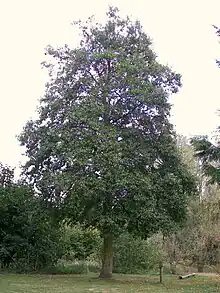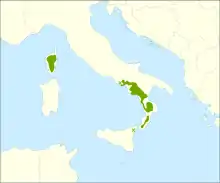| Alnus cordata | |
|---|---|
 | |
| Scientific classification | |
| Kingdom: | Plantae |
| Clade: | Tracheophytes |
| Clade: | Angiosperms |
| Clade: | Eudicots |
| Clade: | Rosids |
| Order: | Fagales |
| Family: | Betulaceae |
| Genus: | Alnus |
| Subgenus: | Alnus subg. Alnus |
| Species: | A. cordata |
| Binomial name | |
| Alnus cordata (Loisel.) Duby | |
 | |
| Distribution map | |
| Synonyms[1] | |
| |
Alnus cordata, the Italian alder,[1][2] is a tree or shrub species belonging to the family Betulaceae, and native to the southern Apennine Mountains (Campania, Basilicata and Calabria, mainly on western mountain sides) and the north-eastern mountains of Corsica.[3] It has been introduced in Sicily, Sardinia, and more recently in Central-Northern Italy,[4][5][6] other European countries (France, Belgium, Spain, Portugal, United Kingdom)[7] and extra-European countries (Chile, New Zealand),[4] where it has become naturalised.
Description
It is a medium-sized tree growing up to 25 m (80 feet) tall[8] (exceptionally to 28 m or 90 feet), with a trunk up to 70–100 centimetres (30–40 in) in diameter. The leaves are deciduous but with a very long season in leaf, from April to December in the Northern Hemisphere; they are alternate, cordate (heart-shaped), rich glossy green, 5–12 cm (2–4+3⁄4 inches) long, with a finely serrated margin.
The slender cylindrical male catkins are pendulous, reddish and up to 10 cm (4 inches) long;[8] pollination is in early spring, before the leaves emerge. The female catkins are ovoid, when mature in autumn 2–3 cm (3⁄4–1+1⁄8 inches) long and 1.5–2 cm (5⁄8–3⁄4 inch) broad, dark green to brown, hard, woody, and superficially similar to some conifer cones. The small winged seeds disperse through the winter, leaving the old woody, blackish 'cones' on the tree for up to a year after.
It has three natural growing shapes. 1) Along rivers with room to grow and plenty of water one base will often give rise to four to six stems, which fan out at some ten degrees from vertical. 2) In open meadows near rivers, marshy ground and flooding can cause trees to angle or tilt over, whereupon over a matter of seasons they grow natural bends to return the upper trunk to vertical. It is not uncommon to find cordatas with S shapes arising from two tilting events. 3) In groves of multiple trees they grow thinner and straighter, such that a grove of a 100 trees can be an excellent renewable source of straight timber good for woodwork.
Cultivation
Like other alders, it is able to improve soil fertility through symbiotic nitrogen fixation with the bacteria Actinomyces alni (Frankia alni).[9] It thrives on much drier soils than most other alders, and grows rapidly even under very unfavourable circumstances, which renders it extremely valuable for landscape planting on difficult sites such as mining spoil heaps and heavily compacted urban sites. It is commonly grown as a windbreak which helps with soil protection.[10]
Alnus cordata has gained The Royal Horticultural Society's Award of Garden Merit.[11]
Bonsai
The Italian Alder makes a medium to large bonsai, a quick grower it responds well to pruning with branches ramifying well and leaf size reducing quite rapidly.[12]
Other uses
The tree also produces valuable reddish-orange wood. It breaks down when exposed to alternating dry and damp air, but is highly durable when kept wet or dry. As demonstrated in the construction of Venice, when immersed in water it lasts for centuries. Also when used within condensation-free, temperature and humidity controlled buildings it has a reputation for maintaining a smooth and naturally shiny finish. The timber is liked by carpenters and used for turning and carving, for moulding, furniture, panelling and plywood.[9]
 Foliage and immature male catkins
Foliage and immature male catkins Female (seed) catkins
Female (seed) catkins
References
- 1 2 "Plants of the World Online | Kew Science". Plants of the World Online.
- ↑ BSBI List 2007 (xls). Botanical Society of Britain and Ireland. Archived from the original (xls) on 26 June 2015. Retrieved 17 October 2014.
- ↑ Gamisans, J. (1983). "L'Aulne à feuilles en coeur Alnus cordata (Loisel.) Loisel. dans son milieu naturel en Corse". Revue forestière française (in French). Nancy: AgroParisTech (3): 187. doi:10.4267/2042/21651. hdl:2042/21651.
- 1 2 Caudullo, G.; Mauri, A. (2016). "Alnus cordata in Europe: distribution, habitat, usage and threats" (PDF). In San-Miguel-Ayanz, J.; de Rigo, D.; Caudullo, G.; Houston Durrant, T.; Mauri, A. (eds.). European Atlas of Forest Tree Species. Luxembourg: Publications Office of the European Union. p. 62.
- ↑ Camarda, I. (1982). "Note su alberi e arbusti della Sardegna" (PDF). Bollettino della Società Sarda di Scienze Naturali (in Italian). 21: 323–331.
- ↑ Cambria, Salvatore. "Alnus cordata (Loisel.) Duby". Flora e Vegetazione della Sicilia. Retrieved 15 July 2016.
- ↑ Shaw, K.; Wilson, B.; Roy, S. (2014). "Alnus cordata. The IUCN Red List of Threatened Species 2014". doi:10.2305/IUCN.UK.2014-3.RLTS.T194657A2356349.en.
{{cite journal}}: Cite journal requires|journal=(help) - 1 2 Rushforth, Keith (1986) [1980]. Bäume [Pocket Guide to Trees] (in German) (2nd ed.). Bern: Hallwag AG. p. 91. ISBN 978-3-444-70130-6.
- 1 2 Ducci, F.; Tani, A. (2009). "Italian alder - Alnus cordata" (PDF). EUFORGEN Technical Guidelines for Conservation and Use. Archived from the original (PDF) on 2016-08-11. Retrieved 2016-10-19.
- ↑ Caudullo, G., Mauri (2016). Alnus cordata in Europe: distribution, habitat, usage and threats. Off. EU, Luxembourg.
- ↑ "Alnus cordata AGM". The Royal Horticultural Society. Retrieved 14 March 2020.
- ↑ D'Cruz, Mark (20 March 2020). "Ma-Ke Bonsai Care Guide for Alnus cordata". Ma-Ke Bonsai. Retrieved 2021-02-04.
External links
- Alnus cordata - distribution map, genetic conservation units and related resources. European Forest Genetic Resources Programme (EUFORGEN)
- Alnus cordata in the CalPhotos photo database, University of California, Berkeley